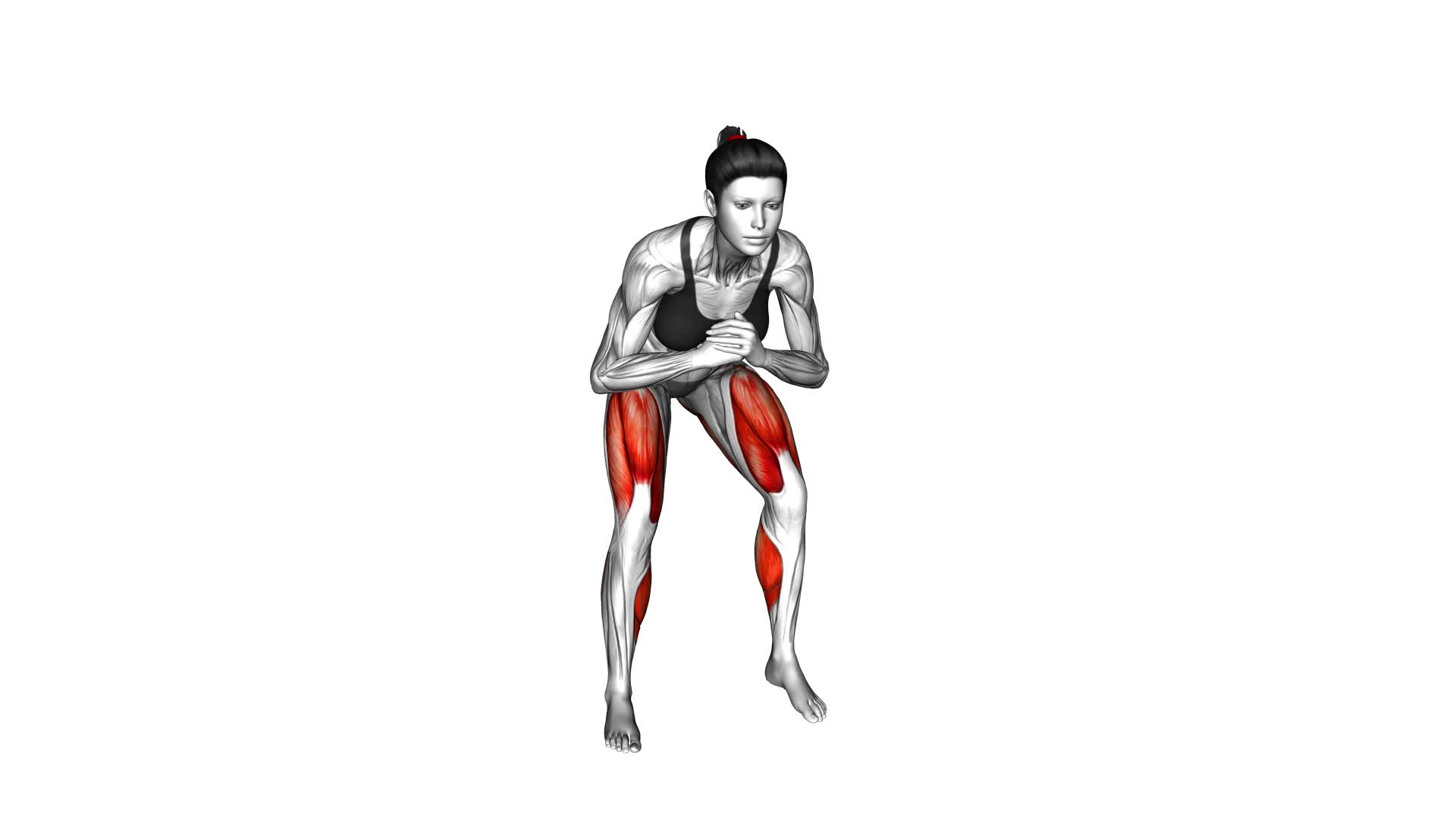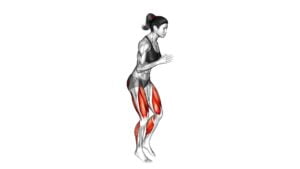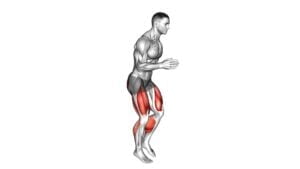Quick Feet (VERSION 2) (female) – Video Exercise Guide & Tips

Get ready to improve your footwork with quick feet exercises! In this video exercise guide, we'll show you how to master quick feet drills specifically designed for females.
Watch This Exercise Video
Boost your agility, speed, and coordination with proper form and technique. No need for fancy equipment – we'll guide you through beginner modifications and progressions.
Avoid common mistakes and follow our sample quick feet workout routine for maximum results.
Let's get those feet moving!
Key Takeaways
- Quick feet exercise improves agility, speed, and performance in sports and activities requiring quick movements and changes in direction.
- Proper form and technique, such as maintaining alignment and avoiding common mistakes, maximize the effectiveness of the exercise and prevent injuries.
- Alignment is important for maintaining balance, stability, and preventing injuries, and good posture engages core muscles.
- Using appropriate equipment like agility ladder, speed hurdles, cones, and resistance bands enhances the benefits of quick feet exercises and builds leg muscle strength and power.
Benefits of Quick Feet Exercise
Improve agility and speed with Quick Feet Exercise.
Quick Feet Exercise is a highly effective training method for improving agility and increasing foot speed. By incorporating this exercise into your routine, you can enhance your performance in various sports and activities that require quick movements and rapid changes in direction.
One of the key benefits of Quick Feet Exercise is its ability to improve agility. Agility is the ability to move quickly and easily with control and coordination. This exercise helps to develop the muscles and joints in your lower body, allowing you to change direction rapidly and efficiently. By practicing Quick Feet Exercise regularly, you can enhance your ability to react quickly to different situations, giving you a competitive edge in sports such as soccer, basketball, and tennis.
In addition to improving agility, Quick Feet Exercise also works to increase foot speed. Foot speed is the speed at which you can move your feet while maintaining control and balance. This exercise involves performing quick, rapid movements with your feet, which helps to strengthen the muscles in your lower legs and increase your overall speed. By consistently practicing Quick Feet Exercise, you can develop faster footwork, enabling you to move swiftly and effectively in sports that require quick bursts of speed, such as sprinting, football, and martial arts.
Incorporating Quick Feet Exercise into your training routine can have significant benefits for improving agility and increasing foot speed. By dedicating time and effort to this exercise, you can enhance your performance in various sports and activities, allowing you to become a more agile and faster athlete.
Proper Form and Technique
To perform the quick feet exercise with proper form and technique, it's important to focus on your alignment. Keep your feet hip-width apart, engage your core, and maintain a neutral spine.
Avoid common mistakes such as hunching your shoulders, rounding your back, or letting your knees collapse inward. By maintaining proper alignment and avoiding these mistakes, you can maximize the effectiveness of the quick feet exercise and prevent injuries.
Importance of Alignment
Ensure your body maintains proper form and technique to maximize the benefits of the Quick Feet (VERSION 2) (female) exercise. Alignment is crucial in dance, as it helps maintain balance, stability, and prevents injuries.
Good posture is essential for proper alignment, as it aligns the spine and engages the core muscles. To achieve correct alignment, stand tall with your shoulders back, chest lifted, and abdomen pulled in. Keep your head in line with your spine and avoid slouching or leaning forward.
Maintaining proper alignment throughout the exercise won't only enhance your performance but also reduce the risk of strain or injury.
Now that you understand the importance of alignment, let's move on to avoiding common mistakes.
Avoiding Common Mistakes
Maintain proper form and technique to avoid common mistakes and maximize the benefits of the Quick Feet (VERSION 2) (female) exercise. By doing so, you can minimize the risk of injury and ensure that you achieve the best possible results.
One common mistake to avoid is rushing through the exercise. Take your time and focus on each movement, making sure to maintain control and stability.
Another mistake to watch out for is neglecting the correct foot placement. Ensure that your feet are properly aligned and land softly on the balls of your feet.
Lastly, be mindful of your posture throughout the exercise. Keep your back straight and engage your core to prevent unnecessary strain on your lower back.
Equipment Needed for Quick Feet Exercise
You'll need a few key pieces of equipment to amp up your quick feet exercise routine. Here are four essential items to consider for your speed training:
- Agility Ladder: An agility ladder is a ladder-shaped tool made of flat rungs that are spaced apart. It helps improve footwork, coordination, and speed. Simply lay it on the ground and perform various drills, such as high knee runs or lateral shuffles, by stepping in and out of the ladder's rungs.
- Speed Hurdles: Speed hurdles are small, adjustable hurdles that you can set up at different heights. They're great for developing quick feet and agility. Start with lower heights and gradually increase as you progress. Practice hopping over the hurdles with both feet or perform single-leg hops for an added challenge.
- Cones: Cones are versatile and inexpensive equipment options. Use them to mark out agility drills, such as the box drill or T-drill, to improve your quickness and change of direction. You can also use cones for speed and reaction drills by setting them up in different patterns and quickly sprinting between them.
- Resistance Bands: Resistance bands are stretchy bands that provide resistance when stretched. They're useful for adding resistance to your quick feet exercises, helping to build strength and power in your leg muscles. Attach the bands to a fixed object and perform lateral shuffles or high knee runs against the resistance for an added challenge.
Beginner Modifications and Progressions
To make the Quick Feet exercise easier, there are several modifications you can try. You can:
- Slow down the pace
- Reduce the number of repetitions
- Perform the exercise on a softer surface to lessen the impact.
As you gain more strength and coordination, you can gradually increase the difficulty by:
- Increasing the speed
- Adding more repetitions
- Incorporating additional movements.
Remember to always maintain proper form and make adjustments as needed to ensure a safe and effective workout.
Easier Exercise Options
For beginner modifications and progressions of the Quick Feet exercise, try incorporating easier exercise options. Here are four options to help you get started:
- Slow down the pace: Begin by performing the Quick Feet exercise at a slower tempo. This will allow you to focus on your coordination and footwork without feeling overwhelmed.
- Reduce the intensity: Instead of jumping or hopping, try stepping from side to side or tapping your feet on the ground. This lower impact variation will still work your lower body muscles while providing a gentler option.
- Use a smaller space: If you find it challenging to move quickly between the cones, decrease the distance between them. This modification will make it easier to maintain the required speed and agility.
- Increase rest intervals: Take longer breaks between sets or repetitions to give yourself more time to recover. Gradually decrease the rest periods as you build up your endurance and confidence.
Advancing Difficulty Gradually
To advance the difficulty gradually and incorporate beginner modifications and progressions, try the following exercises.
Begin by increasing the intensity of the quick feet exercise. You can do this by increasing the speed at which you move your feet. Start with a comfortable pace and gradually work your way up to a faster tempo. As you become more comfortable, challenge yourself to maintain the increased speed for longer periods of time.
Another way to advance the difficulty is to incorporate variations of the quick feet exercise. For example, you can try adding lateral movements or jumping movements while performing the exercise. These modifications won't only increase the intensity but also engage different muscles and improve your agility.
Remember to always listen to your body and progress at a pace that's suitable for you.
Proper Form Adjustments
How can you make proper form adjustments and incorporate beginner modifications and progressions when performing quick feet exercises? Here are four tips to help you maintain proper technique and avoid common mistakes:
- Start with a slower pace: If you're just starting out or find it difficult to keep up with the quick feet movements, begin by performing the exercise at a slower speed. This will allow you to focus on maintaining proper form and gradually build up your speed as you become more comfortable.
- Keep your core engaged: It's important to maintain a strong core throughout the exercise. Engaging your core muscles will help stabilize your body and prevent any unnecessary movements or compensations.
- Focus on footwork: Pay attention to your foot placement and make sure your feet are landing softly and accurately on the ground. Keep your movements light and quick, avoiding heavy stomping or dragging of the feet.
- Practice balance and coordination: Incorporate exercises that target balance and coordination, such as single-leg balance or ladder drills. These exercises will help improve your stability and control, making it easier to perform quick feet exercises with proper form.
Common Mistakes to Avoid
Your mistakes to avoid while performing the Quick Feet exercise (VERSION 2) as a female are crucial for optimal results. By being aware of these common mistakes and implementing the necessary tips for improvement, you can ensure that you're getting the most out of this exercise.
One common mistake to avoid is rushing through the exercise. Quick Feet requires precision and control, so it's important to maintain a steady and controlled pace. By rushing, you risk sacrificing proper form and increasing the likelihood of injury. Instead, focus on maintaining a consistent rhythm and speed that allows you to perform the exercise correctly.
Another mistake to avoid is neglecting proper foot placement. Your feet should be hip-width apart and your weight evenly distributed. Avoid letting your feet collapse inward or splaying them too far apart. This can lead to instability and reduce the effectiveness of the exercise. Pay attention to your foot placement and make adjustments as needed.
Lastly, avoid relying solely on your ankles for movement. Quick Feet is a full-body exercise that requires engagement from your core, hips, and legs. By neglecting these areas and solely relying on your ankles, you limit the effectiveness of the exercise. Focus on engaging your entire lower body and maintaining proper form throughout the movement.
Sample Quick Feet Workout Routine
For an effective Quick Feet workout routine, begin by incorporating a variety of agility drills and exercises. These will help improve your footwork, speed, and coordination. Here is a sample Quick Feet workout routine that you can try:
- Ladder Drills: Set up an agility ladder and perform various exercises such as ladder hops, side shuffles, and high knees. This will challenge your quickness and agility.
- Cone Drills: Set up cones in a zigzag pattern and perform quick feet movements around them. You can try different variations like forward and backward movements, lateral shuffles, and figure-eight patterns.
- Box Jumps: Place a box or step in front of you. Jump onto the box using a quick feet motion and then jump back down. This exercise won't only work on your footwork but also improve your explosive power.
- HIIT Circuit: Incorporate quick feet exercises into a high-intensity interval training (HIIT) circuit. Combine quick feet movements with other exercises like burpees, mountain climbers, and jump squats. This will give you a full-body workout while challenging your cardiovascular endurance.
By incorporating these quick feet workout variations and incorporating quick feet into HIIT workouts, you can enhance your agility, speed, and overall fitness level. Remember to start at a comfortable pace and gradually increase the intensity as you progress.
Stay consistent and enjoy the benefits of improved quick feet!
Frequently Asked Questions
How Many Calories Can You Burn by Doing the Quick Feet Exercise?
By doing the quick feet exercise, you can burn a significant amount of calories. This exercise involves rapid movements of the feet, which helps elevate your heart rate and increase your overall calorie expenditure.
Quick feet exercise is a great way to improve your cardiovascular fitness and burn calories, making it an effective addition to your workout routine.
The benefits of quick feet include improved agility, coordination, and lower body strength.
Can Quick Feet Help Improve Agility and Coordination?
Quick feet exercises can definitely help improve agility and coordination. By incorporating quick feet movements into your workout routine, you'll be able to enhance your ability to change direction quickly and react faster.
These exercises require rapid foot movements, which engage various muscles in your legs and core. Some of the best quick feet exercises include ladder drills, cone drills, and high knee runs.
Regularly practicing these exercises can have significant benefits for your overall athletic performance.
Are There Any Age Restrictions for Doing Quick Feet Exercises?
There are no age restrictions for doing quick feet exercises. These exercises can be beneficial for older adults as they help improve agility and coordination.
However, it's important to make modifications for individuals with mobility issues. They can perform quick feet exercises at a slower pace or use support like a chair or wall for stability.
It's always recommended to consult with a healthcare professional before starting any new exercise routine, especially if you have any concerns or medical conditions.
How Long Should a Quick Feet Workout Session Last?
To get the most out of your quick feet workout, it's important to know how long to go for. A quick feet session should typically last around 15-20 minutes.
But before you jump right in, make sure to warm up properly. This will help prevent injuries and prepare your muscles for the intense workout.
There are also different variations of quick feet exercises that you can incorporate to keep things interesting and challenge yourself.
Can Quick Feet Exercises Be Incorporated Into a HIIT (High-Intensity Interval Training) Routine?
Yes, quick feet exercises can definitely be incorporated into a high-intensity interval training (HIIT) routine. They offer numerous benefits, such as improving agility, speed, and coordination.
You can include variations of quick feet exercises like ladder drills, cone drills, or box jumps to make your HIIT workout more challenging and effective.
Conclusion
In conclusion, incorporating quick feet exercises into your workout routine can provide numerous benefits. These include improved agility, coordination, and cardiovascular endurance.
By maintaining proper form and technique, using the necessary equipment, and gradually progressing in difficulty, you can maximize the effectiveness of this exercise.
It is also important to be mindful of common mistakes to avoid. Additionally, consider trying a sample quick feet workout routine to challenge yourself and achieve your fitness goals.

Author
Years ago, the spark of my life’s passion ignited in my mind the moment I stepped into the local gym for the first time. The inaugural bead of perspiration, the initial endeavor, the very first surge of endorphins, and a sense of pride that washed over me post-workout marked the beginning of my deep-seated interest in strength sports, fitness, and sports nutrition. This very curiosity blossomed rapidly into a profound fascination, propelling me to earn a Master’s degree in Physical Education from the Academy of Physical Education in Krakow, followed by a Sports Manager diploma from the Jagiellonian University. My journey of growth led me to gain more specialized qualifications, such as being a certified personal trainer with a focus on sports dietetics, a lifeguard, and an instructor for wellness and corrective gymnastics. Theoretical knowledge paired seamlessly with practical experience, reinforcing my belief that the transformation of individuals under my guidance was also a reflection of my personal growth. This belief holds true even today. Each day, I strive to push the boundaries and explore new realms. These realms gently elevate me to greater heights. The unique combination of passion for my field and the continuous quest for growth fuels my drive to break new ground.







